Opinion
Why MoMA’s Exhibition of Towering Brazilian Modernist Tarsila do Amaral Misses the Mark
The museum's overly formalist approach misses out on an opportunity to delve into the politics of Brazilian Modernism.
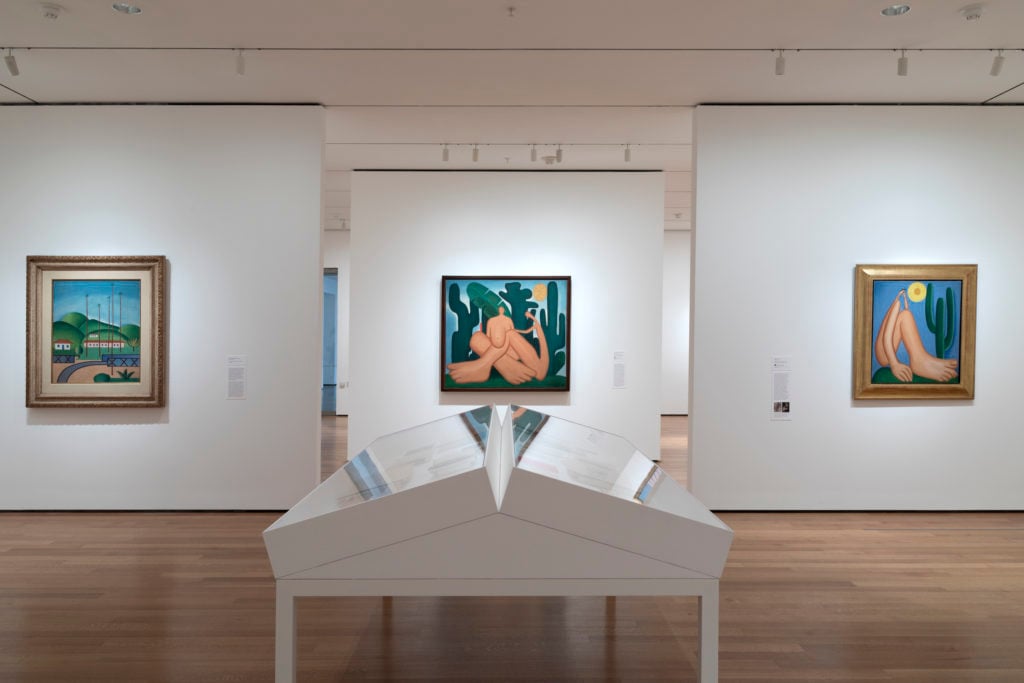
The museum's overly formalist approach misses out on an opportunity to delve into the politics of Brazilian Modernism.

Sara Roffino

Visitors to “Tarsila do Amaral: Inventing Modern Art in Brazil” at New York’s Museum of Modern Art, the first exhibition in the US dedicated to the groundbreaking Brazilian Modernist, are greeted by a moderately sized painting of a black woman sitting on the ground in front of a lone banana leaf.
Years after its creation, the artist described the Cubist-style nude figure as having a “heavy breast hanging over her arm” and “huge, pendulous lips.” Simply titled A Negra (The Black Woman) (1923), the painting is believed to be modeled on a woman who worked for Tarsila’s coffee-plantation-owning family—and who, then, was born into slavery, which did not end in Brazil until 1888. (Tarsila is such a towering figure in Brazil that she is commonly referred to by her first name.)
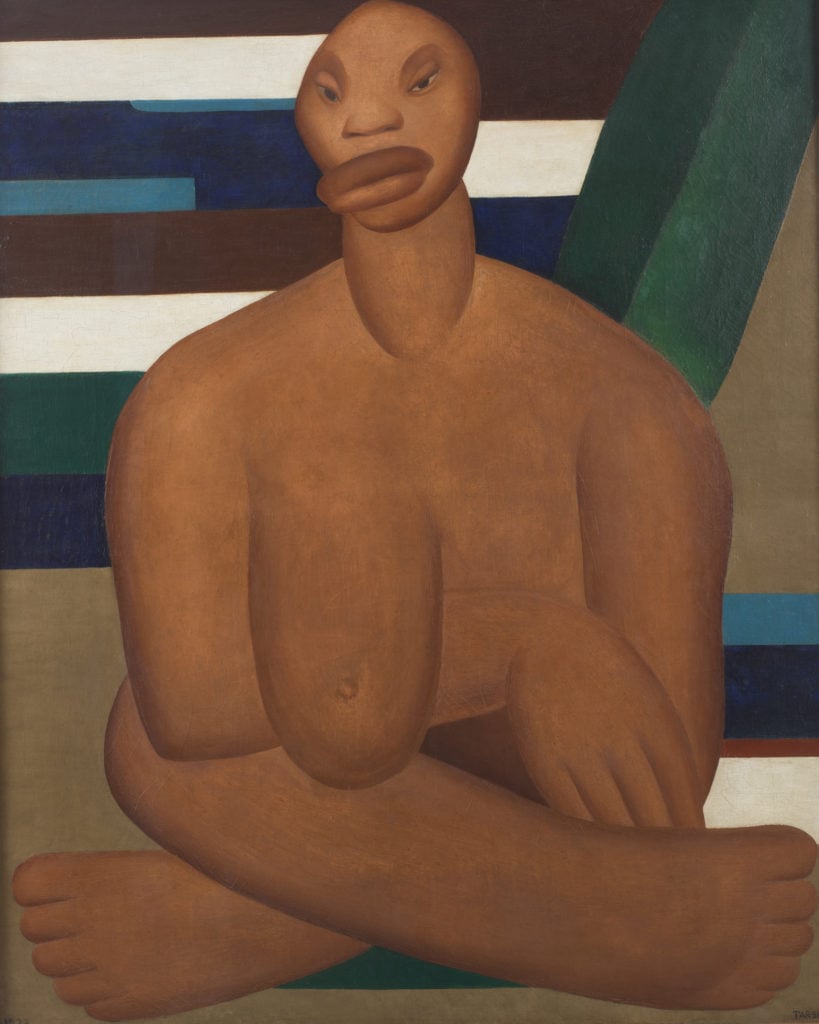
Tarsila do Amaral’s A Negra (1923). Museo de Arte Contemporânea de Universidade de São Paulo. © Tarsila do Amaral Licenciamentos.
A Negra was first exhibited in Paris in 1926. MoMA’s catalogue notes that the Brazilian writer José Severiano de Rezende “praised Tarsila’s portrayal… as a sign of the artist’s true and sensitive understanding of African-Brazilians.” However, Tarsila ultimately chose not to include A Negra in her first solo exhibitions in Rio de Janeiro and São Paulo three years later. In 1939, she called the painting “very controversial,” though she did not divulge the specifics of the controversy. Like Tarsila, MoMA glosses over the complexity of the work.
The show is an overdue US presentation of one of the most influential artists in Latin America and is exceptional for bringing together her three most important works—A Negra, Abaporu (1928), and Anthropofagia (1929)—along with a selection of other canvases, works on paper, and ephemera.
However, the show is also a missed opportunity. Although the exhibition’s curators Luis Pérez-Oramas and Stephanie D’Alessandro write in the catalogue that they are taking on “issues of race, class, and gender in Brazil and between Brazil and France, as well as larger matters of nationalism and internationalism, primitivism and colonial history,” this mission fails to translate. Instead, the show is overly focused on formal aspects of Tarsila’s work—leaving conspicuous holes in her career trajectory and big questions about her legacy and relevance today unanswered.
Born into a wealthy farming family in 1886, Tarsila spent her formative years traveling between Paris, where she studied with André Lhote and Fernand Léger, and São Paulo, where she was a vital link between the European and Brazilian Modernist movements. Her paintings became the aesthetic reference for a movement that became known as Anthropofagia.
The idea is most widely understood as a form of cultural cannibalism in which Brazilians consume qualities from other cultures (European, indigenous, and Afro-Brazilian) in order to create a uniquely Brazilian artistic identity.
Intended as a rejection of European cultural domination, Anthropofagia formally emerged in 1928 in the Cannibalist Manifesto written by Tarsila’s husband, Oswald de Andrade. After he saw Tarsila’s painting Abaporu, a striking painting of a woman looming high above a cactus, he searched through a Tupi-Guarani dictionary to find an appropriate title, settling on a combination of aba (which means “person”) and puro (which means “who eats”). The fundamental ethos of Anthropofagia was that Brazil did not need to adhere to the tenets of Modernism on European terms, but instead could digest European thinking along with specific Brazilian cultural practices.
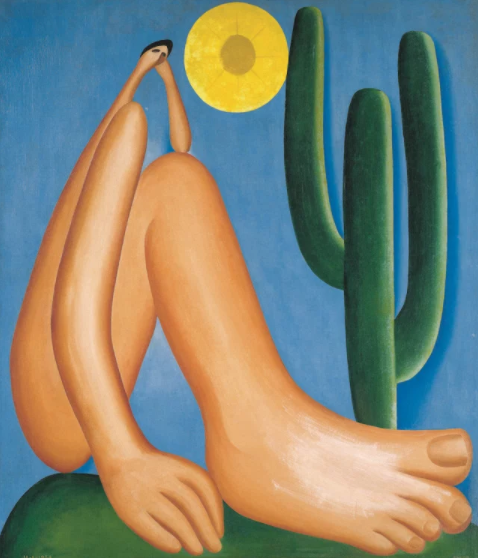
Tarsila do Amaral, Abaporu (1928). Image courtesy MALBA.
It was a radical proposition for its time and has served as a celebrated foundational ideal of Brazilian modernity. But the fact remains that Anthropofagia’s proponents were most often lighter-skinned urbanites from elite social contexts—those with political, social, and economic capital. And while the consumption of European culture was explicit, so was the consumption of indigenous and Afro-Brazilian culture. The fine line, if there is one, between Anthropofagia and cultural appropriation—as it is considered within North American discourses both popular and academic today—remains vague.
Of course, Brazilian Modernism must be understood as its own, independent history. We cannot read art that was made in 1923 by a Brazilian painter in Paris as if it had been made in 2018 in New York. But we must ask what it means to present such work here and now—and how its reading may have changed over the past century. The MoMA show does none of this.
A revealing example of the way MoMA avoids the more complicated questions about Anthropofagia is its consideration of the painting A Negra. In her catalogue essay, D’Alessandro positions the Brazilian figure in conversation with the bathers of Cézanne, Picasso, Léger, and Derain, all of which were on view in Paris while Tarsila was there. She notes that such images “drew upon the concept of the noble savage and its long and complicated history of colonialist and primitivist association.” A photograph of the woman believed to be the model for A Negra is included on the wall label, but D’Alessandro fails to explain how this theme might be different, or magnified, when the figure depicted is a slave or servant of the artist.
Further, D’Alessandro quotes Tarsila discussing A Negra in a 1972 interview: “A female slave lived on our fazenda [farm], and she had droopy lips and enormous breasts because (I was later told) in those days black women used to tie rocks to their breasts in order to lengthen them, and then they would sling them back over their shoulders to breastfeed the children they were carrying on their backs.”
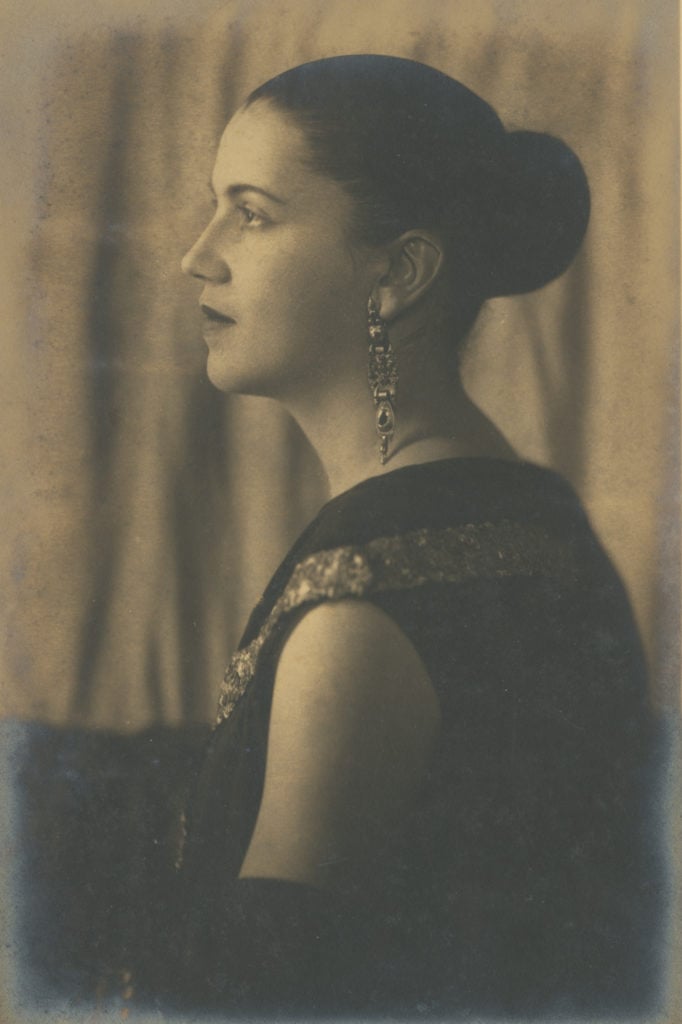
Portrait of Tarsila do Amaral in profile, mid-1920s. Pedro Corrêa do Lago Collection, São Paulo.
But rather than consider the content of this interview or its implications for the work itself, D’Alessandro uses Tarsila’s words to further the idea of Anthropophagic consumption. She writes that it is “an example of the powerful process of accumulation, or continued ingestion, that was at the root of her conception of A Negra as a bather.” In other words, D’Alessandro uses the figure’s physical distortion—done in the service of her forced labor—as a key to Tarsila’s aesthetic style.
Had D’Alessandro instead considered what it might mean to view this painting through the layered racial and economic circumstances in which it was made, the conversation could have become more timely, relevant, and ultimately more revealing of the work itself. Yet this exhibition seems to have been planned in a bubble. Racial tensions may be dealt with differently in Brazil and the United States, but isn’t an exhibition of this sort the perfect opportunity to look at how and why they are different and what that has meant for their respective art histories?
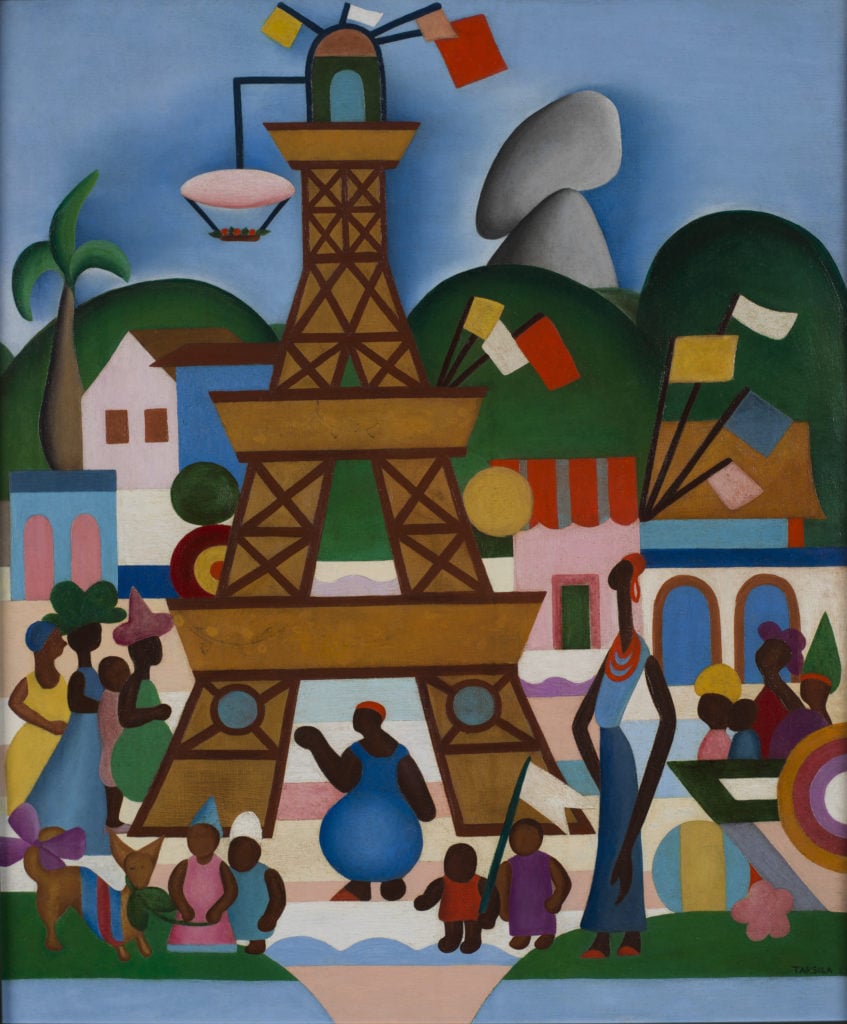
Tarsila do Amaral’s Carnival in Madureira (Carnaval em Madureira) (1924). Acervo da Fundação José e Paulina Nemirovsky, em comodato com a Pinacoteca do Estado de São Paulo. © Tarsila do Amaral Licenciamentos.
MoMA’s strict formalist approach—at the cost of context and meaning—is especially dismaying because it is part of a pattern for which the museum has been criticized in the past. In a 2010 text, “In the Wake of the Negress,” which deals with black women artists in MoMA’s collection, art historian Huey Copeland writes: “MoMA has historically emphasized the individual author, medium specificity, and formalist conception of quality, often denuding even the most politically astute art of its context and downplaying artists’ ambitions for social change in favor of a Modernist narrative based on stylistic progression.”
The show also does a disservice to Tarsila’s own evolving understanding of race and class by focusing primarily on her early years. In 1929, her family lost their fortune in the stock market crash and she split from Andrade. The following year brought a revolution and an authoritarian government to Brazil. In 1931, Tarsila traveled to the Soviet Union and was imprisoned upon her return to Brazil for her political activities.
She subsequently embraced Marxism and began to make more explicitly political work, focusing on social realist depictions of laborers and workers. Her 1933 canvas Operários (Workers), on view at MoMA, is a striking representation of the direction Tarsila’s work took following her trip to Russia. The canvas depicts a large group of stone-faced laborers, of all different skin tones, looking into the distance. Behind them, a turquoise sky is interrupted by smokestacks emitting dark fumes. It is the only work in the show made after her trip to Russia.
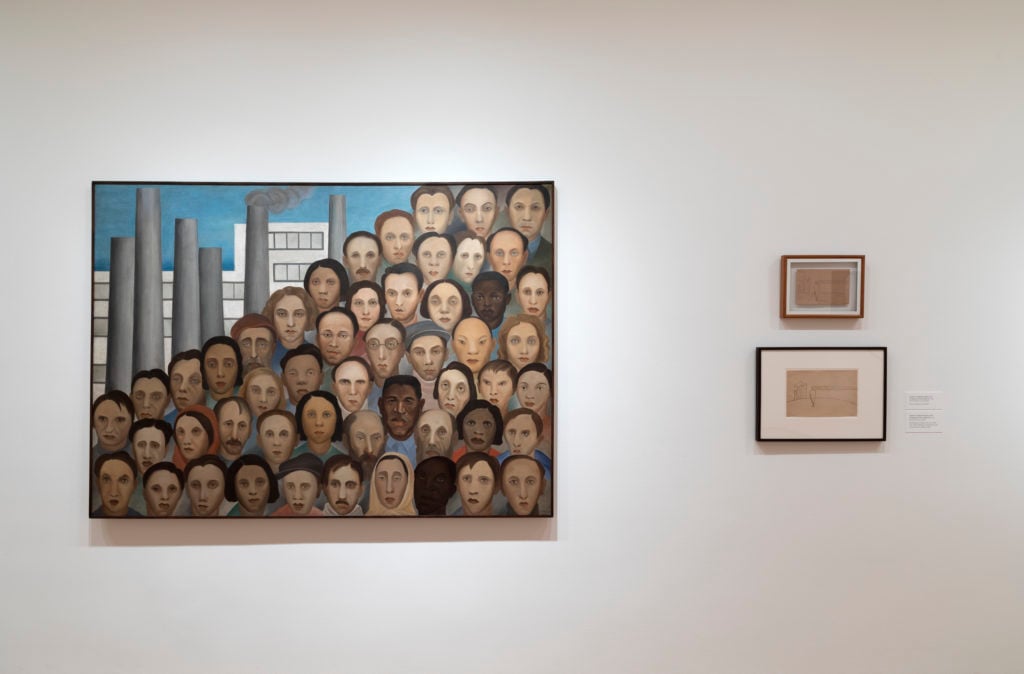
Installation view of Workers (Operarios) (1933) from “Tarsila Do Amaral: Inventing Modern Art in Brazil” at the Museum of Modern Art. © 2018 The Museum of Modern Art. Photo: Robert Gerhardt.
It’s fine to limit the exhibition to Tarsila’s early years, but her early output must be considered in relation to what came later, for it is through the artist’s own development that we gain greater understanding into her thinking. The fact that she spent the years from 1930 onward explicitly addressing issues of class, consumption, capitalism, and exploitation of people and land makes it clear that her life’s work was far from limited to purely formal innovation or a nostalgic search for identity.
It’s a shame this exhibition rejects the difficult issues—which were of direct concern to Tarsila and of major importance in contemporary art—in favor of toeing the formalist art historical line. MoMA positions the show as a progressive response to Eurocentric art history, and indeed, an exhibition of Tarsila do Amaral is the perfect opportunity to realign thinking around ideas of Modernism. But in failing to thoroughly present the layered nuances of the work, MoMA reinforces the very conservative landscape they claim to dismantle.
“Tarsila do Amaral: Inventing Modern Art in Brazil” is on view at the Museum of Modern Art, New York, until June 3.